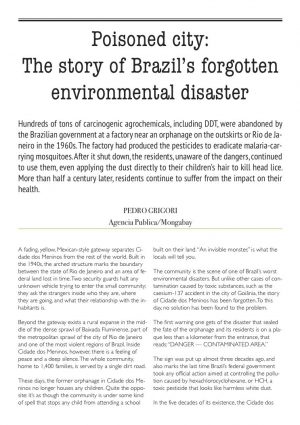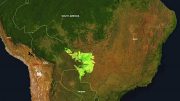 Hundreds of tons of carcinogenic agrochemicals, including DDT, were abandoned by the Brazilian government at a factory near an orphanage on the outskirts or Rio de Janeiro in the 1960s. The factory had produced the pesticides as part of the government’s push to eradicate malaria-carrying mosquitoes. After it shut down, the residents, unaware of the dangers of the chemicals, continued to use them, even applying the dust directly to their children’s hair to kill head lice. More than half a century later, residents continue to suffer from the impact on their health, with 73% of those tested having high levels of contamination in their bodies.
Hundreds of tons of carcinogenic agrochemicals, including DDT, were abandoned by the Brazilian government at a factory near an orphanage on the outskirts or Rio de Janeiro in the 1960s. The factory had produced the pesticides as part of the government’s push to eradicate malaria-carrying mosquitoes. After it shut down, the residents, unaware of the dangers of the chemicals, continued to use them, even applying the dust directly to their children’s hair to kill head lice. More than half a century later, residents continue to suffer from the impact on their health, with 73% of those tested having high levels of contamination in their bodies.
A fading, yellow, Mexican-style gateway separates Cidade dos Meninos from the rest of the world. Built in the 1940s, the arched structure marks the boundary between the state of Rio de Janeiro and an area of federal land lost in time. Two security guards halt any unknown vehicle trying to enter the small community; they ask the strangers inside who they are, where they are going, and what their relationship with the inhabitants is.
Beyond the gateway exists a rural expanse in the middle of the dense sprawl of Baixada Fluminense, part of the metropolitan sprawl of the city of Rio de Janeiro and one of the most violent regions of Brazil. Inside Cidade dos Meninos, however, there is a feeling of peace and a deep silence. The whole community, home to 1,400 families, is served by a single dirt road.
These days, the former orphanage in Cidade dos Meninos no longer houses any children. Quite the opposite: it’s as though the community is under some kind of spell that stops any child from attending a school built on their land. “An invisible monster,” is what the locals will tell you.
The community is the scene of one of Brazil’s worst environmental disasters. But unlike other cases of contamination caused by toxic substances, such as the caesium-137 accident in the city of Goiânia, the story of Cidade dos Meninos has been forgotten. To this day, no solution has been found to the problem.
The first warning one gets of the disaster that sealed the fate of the orphanage and its residents is on a plaque less than a kilometer from the entrance, that reads: “DANGER — CONTAMINATED AREA.”
The sign was put up almost three decades ago, and also marks the last time Brazil’s federal government took any official action aimed at controlling the pollution caused by hexachlorocyclohexane, or HCH, a toxic pesticide that looks like harmless white dust.
In the five decades of its existence, the Cidade dos Meninos orphanage was home to almost 5,000 orphans and street children from Rio de Janeiro and other states across Brazil. The wider community was also home to the orphanage’s employees, who were provided housing in the area and made a life for themselves and their families there.
A poison factory
Long before the COVID-19 pandemic, malaria was the main infectious disease in Brazil. In the first half of the 20th century, Baixada Fluminense was one of the main hotspots of the disease. It was in this context that the Ministry of Education and Heath made use of eight disused buildings in Cidade dos Meninos to set up the Institute of Malariology in 1947, the same year the orphanage was founded.
The institute’s founding purpose was to “carry out studies, research and investigations on malaria.” However, spurred on by the desire to transform Brazil into an “industrial powerhouse,” three years later the installations started to be used to produce insecticides to fight the mosquitoes that spread the disease.
“We are going to free our country’s economy from the heavy burden of importing chemical products,” Pedro Calmon, the minister of education and health at the time, said during the inauguration of the HCH factory in the middle of Cidade dos Meninos.
In official correspondence dated between 1947 and 1960, the foundation that ran the orphanage made a number of complaints to the Ministry of Education and Health. They said the size of the institute was being expanded without consent, complained about the proximity of the insecticides to the children living in the orphanage, and reported that a group of the factory’s employees was setting a bad example for the young residents.
The premises of the Institute of Malariology’s factory were expanded and the insecticide production was increased. Among the new chemical products produced on site were benzene hexachloride (BHC) and dichlorodiphenyltrichloroethane(DDT) pastes, 1080 (sodium fluoroacetate), and calcium cyanide — all byproducts of HCH, an organochlorine. The factory also started to produce medication, such as penicillin and tetracycline, among others.
Production only came to a complete stop in 1960, owing to the repeated requests of the Christ the Redeemer Shelter Foundation. However, when the factory closed its doors, the machinery and equipment were not the only things left behind. Dozens of cardboard vats containing nearly 400 metric tons of pure HCH, as well as barrels filled with raw materials and residual waste were also carelessly left on site or disposed of improperly.
At the time, little was known about the problems caused by the pesticides. “Nowadays we know that these substances are extremely harmful to people’s health,” says Ana Cristina Simões Rosa, a doctor in public health and the environment from the Oswaldo Cruz Foundation, Brazil’s leading biosciences research institute. “The chemical structure of these substances is similar to our natural hormones, which facilitates their entry into the body’s metabolic pathways,” she says. Once inside the human body, the consequences are enormous. “It is a carcinogenic substance. It disrupts the functioning of the endocrine system, produces neurocognitive changes and alters the nervous system,” Simões Rosa adds.
Studies have repeatedly shown that HCH can cause cancer, fetal and birth defects, sudden miscarriages, and changes to the nervous system. Regulatory agencies have also discovered another troubling characteristic of such substances: their accumulation in the environment. “Organochlorines have a very stable chemical structure, both in the natural environment and in the human body, which means they take years to decompose. Using a substance that doesn’t decompose as an insecticide is a disaster,” Simões Rosa says.
Brazil only banned the use of HCH in 1985, by which point it had already been taken off the market in dozens of other countries. Even so, it continued to be used in anti-disease campaigns until 1995.
Rosália Maria de Oliveira, also with the Oswaldo Cruz Foundation and the author of one of the main academic studies on Cidade dos Meninos, says that despite the warnings coming from the scientific community, the government continued to carelessly use organochlorine pesticides, believing they represented “progress.” “The scientific authorities’ worldview was guided by the belief in the benefits brought about by scientific and technological advances,” she says.
‘We used to have ‘powder fights’ as kids’
Weathered over the years by the sun and the rain, the cardboard vats containing the HCH started to fall apart, and the white powder was left strewn across the floor. A number of other chemical substances were also forgotten about in the factory. Exactly which substances these were remains unknown to this day, but it’s thought that between 300 and 400 metric tons of HCH alone were left on site, according to the Rio de Janeiro State Foundation for Engineering and the Environment (FEEMA).
“The residents used to say: if it were dangerous, the government wouldn’t have left it here,” says Miguel da Silva, a community leader.
“We used to use the powder for everything,” adds Maria Sarmento, 93, the community’s oldest remaining resident. “We used to put it in our houses to kill mosquitoes; if a child had head lice, we would either shave all their hair off or cover it in the powder. It was our go-to, heal-all medicine.”
In the absence of any notice or sign that warned about the dangers concealed within the factory, the residents of the community came and went without concern. In the hands of the children, the poison became a toy. They used to throw small rocks of the powder at each other, in a game akin to a paintball fight. “The game we used to play here was ‘powder wars,’” Miguel says as he walks through the forest near the old factory. “The factory was full of hiding places, so we used to go there and play. The little rocks of HCH powder used to crumble into dust when you hit someone with it, so we used to pick up little bits of it from the floor and throw it at our friends.”
The children of the community used to squeeze the valves of the chlorine cylinders so they could see the “yellow gas” burst out, and would aim it at one another. They treated as treasures the powders of all colors that they found hidden in drawers.
Miguel’s family, like many others, believed that the toxic pesticide was in fact a medicine, hence their willingness to apply it directly to their children’s scalps to kill lice. “Now I’m nearly bald, but back then I had a lot of hair,” Miguel says, laughing. “If people get infected by putting their hands in the powder, or by eating a guava fruit from a tree near the factory, imagine what it used to do to us when we put it in our hair.”
The poison was even used in public works in the area. At least 360 metric tons of HCH powder were spread across Cidade dos Meninos in little over 20 years. Adults and employees of the children’s shelter also made use of the factory and the materials left behind there to build huts or chicken coops. “Since there wasn’t anyone there keeping an eye on things, whatever was left behind at the factory became communal property,” Miguel says.
The pesticide even ended up in the markets of Duque de Caxias, the neighboring city, where residents sold it rolled up in newspapers. It was this practice that caught the attention of the media. The story only started to gain traction, however, in July 1989, when newspapers in Rio de Janeiro released a series of reports on contamination caused by agrochemicals.
That same month, FEEMA surveyed the area and found nearly 40 metric tons of pure HCH powder. The powder was removed and taken to São Paulo, where it was destroyed. FEEMA also took soil and fruit samples from Cidade dos Meninos. The results of the subsequent analysis: HCH was present in every single one of the samples taken.
Three years later, results from laboratory tests identified HCH in blood samples taken from 31 people from seven families living within 100 meters (330 feet) of the old factory.
Nevertheless, public interest in the Cidade dos Meninos case did not last long. Oliveira, the Oswaldo Cruz Foundation researcher, analyzed every report published on the pollution at Cidade dos Meninos between the 1940s and 2006 for her doctoral thesis, which was published later that year. It showed that the media closely followed the case in the early 1990s, but as the years went by, the number of reports diminished and the tragedy began to be forgotten about without ever having been solved.
The ‘solution’ that made things worse
In 1993, a number of federal, state and municipal bodies signed an agreement accepting responsibility for the chemical pollution in Cidade dos Meninos. The Ministry of Health assumed responsibility for the “complete and permanent decontamination of the area.”
To carry out the work, the Ministry of Health chose one of Brazil’s biggest agrochemical producers, Nortox Agro Química. In collaboration with the University of Campinas (Unicamp), the company decided to use quicklime to cover the chemical pollution. The operation became something of an event in the community, and the residents watched from up close as the factory was demolished and the quicklime was applied in September 1995.
Miguel says the period during which Nortox worked in the community was the “worst moment” for the residents. “They created an even bigger problem. That was the period in which the highest number of our neighbors died,” he says. Several other residents we speak with tell the same story.
The Ministry of Health said the quicklime treatment managed to remove 98% of the chemical contaminants. Nortox echoed this. “Taking into account the situation which prevailed in the community for 30 long years, the existing quantities of toxic substances no longer represent any kind of risk to the health of the population or the environment,” the company said in a 1996 report on the decontamination efforts.
However, at least 10 different studies carried out in the following years have shown that the quicklime treatment was ineffective. Analysis done in 1999 by Oswaldo Cruz Foundation researcher Helena Pinto Bastos went even further, detailing how the failed decontamination attempts carried out by Nortox actually made the situation worse. In 1989, FEEMA had judged the total size of the contaminated area to be 13,000 square meters (nearly 140,000 square feet). The area in which Nortox had buried the quicklime-treated waste resulting from the demolition of the factory, however, measured 33,000 m2 (355,000 ft2). Since the decontamination efforts were unsuccessful, all of the ground that came into contact with the chemicals ended up becoming contaminated, meaning in effect the contaminated area had tripled in size.
When contacted for comment, Nortox declined to make a statement on the matter.
With the contamination of the area ongoing, the Ministry of Health started to search for other ways to deal with the issue. It reached out to Japan, Germany, the Netherlands, the U.S., the U.K. and Canada. But to this day, no proposal has come to fruition.
It’s in the blood
Sixty years after the closure of the factory, the pesticide remains in the community. And it’s not restricted to the area where the factory once stood, or on the walls plastered with paste made from the white powder. High levels of the carcinogens have been found in the blood of 95% of 1,400 inhabitants who were tested, according to the Oswaldo Cruz Foundation.
The chemical pollution forced the orphanage and the public school to close. And, with them, went the remaining jobs in Cidade dos Meninos. The residents couldn’t even plant crops or raise animals in the area. In 1999, every animal in Cidade dos Meninos was slaughtered in an attempt to reduce the spread of the contaminants, which can be passed on through meat and other animal products.
Despite this, people still live in Cidade dos Meninos. The “natives,” as the oldest residents are known, are engaged in a decades-long struggle to remain in their community, even amid government neglect and the inordinately high number of cancer cases.
Where the pesticide factory once stood, there’s now a eucalyptus plantation, planted specifically to act as a kind of natural wall, preventing the wind from blowing toxic dust over the rest of the community.
“There’s no way you can miss my house. If you can’t find it, just ask someone where ‘Powder Miguel’ lives, and they’ll show you”, Miguel says. “They used to use [this name] as a kind of joke. ‘Powder Miguel,’ they called me, because that’s all I would talk about.” And it’s true: nobody has spoken about and struggled against the contamination more than he has.
In the same period when the chemical pollution was discovered, a tragedy transformed a young Miguel into “Powder Miguel.” “My little brother died from liver cancer. He was only 19 years old. When we discovered the effects that the chemical powder could cause, I thought that my brother’s death could have something to do with it. My anger at what had happened started to grow and grow,” he says.
Miguel took part in a number of lawsuits aimed at trying to get the area decontaminated. He told the story of Cidade dos Meninos at lectures, public hearings, and at meetings with city councilors, state and federal legislators, and even with ministers of health. He assumed the role of spokesman for the community and traveled to the capital, Brasília, several times at the invitation of the federal government to discuss the future of the community. In 1992, he managed to bring the then-minister of health, Adib Jatene, back to Cidade dos Meninos to get to know the area personally.
“What has to leave here is the powder, not the people,” he says when asked why he and his family continue to live there. Miguel’s house is the closest to the old factory. All the other houses that were located even closer were either expropriated or demolished.
His decades-long fight for the decontamination of Cidade dos Meninos didn’t bring Miguel praise or recognition. Quite the opposite: over the years he has even received death threats. At 58, Miguel has gone through a lot. His experiences have made him an expert storyteller. He has a degree in geography, has served in the army, was the municipal secretary for the environment of Duque de Caxias, and stood for City Council, unsuccessfully, with the sole purpose of using his allocated political advertising time to talk about agrotoxins.
“I was born in 1963 and moved here in 1965. I learned to walk in Cidade dos Meninos,” Miguel says. His father, a butcher, arrived with the family at the invitation of an uncle who worked in the orphanage. “He used to say that there was no way you’d go hungry here. You could plant and raise whatever you needed to eat.” Miguel studied at the local school, Sarah Kubitschek Municipal College, alongside the children from the orphanage. “They had a good life — five meals a day! When I used to argue with my mum, I’d ask her to send me to the orphanage,” he laughs.
As he takes us through the ruins of the factory, Miguel recalls how, on the same day that he received the news from the government that the funding for the decontamination work had been authorized, the courts decided to close the orphanage and all of the schools in Cidade dos Meninos. “A lot of people thought it was my fault. They said that I was responsible for the school closures, for the orphanage shutting down,” he says. “I was born after the factory closed, it wasn’t me that left that poison there.”
At the start of this year, Miguel lost another brother, his eldest. “He had battled against lung cancer for a long time, but it took a toll on his body and he grew weak, and died of a heart attack,” he says.
A study carried out by the Oswaldo Cruz Foundation in 2002 drew a link between exposure to the white chemical dust and the incidence of cancer in the region. Throughout the 1980s and 1990s, inhabitants who lived within 12 kilometers (7.5 miles) of the factory had a higher mortality rate for cancer of the pancreas, liver, larynx, bladder and blood among men, and of pancreatic and blood cancer among women, when compared to populations further away from the factory.
‘It was very lively here, there were a lot of parties’
At 93, Maria Sarmento is the oldest resident of the Cidade dos Meninos community. When we meet her, she’s holding a photo album in her hands. “There used to be a little lake here, but it was filled in because of the powder. Not even a single fish could survive there any longer,” she says, pointing to a black-and-white photograph.
Her family arrived in the area in 1949, two years after the orphanage opened. She was a nursing assistant and her husband a nurse. “When the pesticide factory opened, they had to open a health clinic in the orphanage, so we came to look after the children,” Maria says.
Maria lives in one of the first houses to be built in Cidade dos Meninos. Seated in a chair in front of a large blue window, she shows us the spacious living room. “It’s a really nice house, very well built. It could withstand a hurricane. And it’s enormous.” It’s so big that it was divided into two. She lives in the front part of the house, and at the back lives Tereza da Silva, 85. Upon hearing the sounds of visitors, Terezinha, as she’s known, quickly appears on her neighbor’s veranda.
Tereza arrived in 1960 along with her husband, who, as a child, had grown up in the orphanage and had returned, years later, as a member of the staff. “It was very lively here, there were a lot of parties. Church parties, forró dances,” Terezinha says. “My husband died, but nowadays I live here with my granddaughters, and plenty of other women who come to visit me.”
The orphanage opened its doors before construction had even been completed. The children’s living quarters were divided into four different buildings, where they were placed according to their age and level of schooling. As well as studying, sleeping and eating, they took part in vocational courses, such as mechanics, woodwork, welding and metalworking.
The main focus of extracurricular activities was farming. The community planted their own food, and raised cattle, poultry and pigs. They were self-sufficient, producing everything that they consumed, and even used to have a surplus to sell to neighboring communities.
The students who worked on the farms were remunerated for their work and encouraged to deposit their earnings in an account so that they would have some savings when they left the orphanage.
Half a century later, 73% of residents remained contaminated
In 2000, the Ministry of Health carried out a major risk assessment of the soil, water, air and food sources of the Cidade dos Meninos community, as well as took blood samples from the residents. The results only came to light in 2005, under pressure from the residents, who threatened to take the government to court over the matter.
The results of the laboratory tests showed that 95% of the 1,400 inhabitants of Cidade dos Meninos who were tested had been contaminated, with 30% showing high levels of toxicity. Only 2% of the residents tested showed no signs of contamination.
Simões Rosa, who works at the Oswaldo Cruz Foundation’s Center for the Study of Worker´s Health and Human Ecology (Cesteh), and who carried out the tests, says: “The study confirmed that the population [of Cidade dos Meninos] showed changes in their thyroid hormones, changes to testosterone levels in men and estrogen levels in women.”
A follow-up assessment of the population only began in 2018. It remains incomplete because of the COVID-19 pandemic. However, Agência Pública reporters had access to a report that was delivered to the residents, containing the results of the blood tests done between 2018 and 2019. Of the 750 people tested, 73.5% had residues of organochlorine pesticides, such as HCH and DDT.
The tests also brought good news. The levels of contamination were 10 times lower than those found in the test results released in 2005. “Over time, these molecules degrade bit by bit,” Simões Rosa says.
Now, the residents complain about their access to health care. When someone in the community feels ill, the nearest medical facility is the small community health center, where there’s only one doctor. According to the Ministry of Health, the Cidade dos Meninos Basic Health Unit employs six community health agents, one nurse, one nurse technician, a dentist, and a dental health assistant.
Agência Pública reporters contacted the Ministry of Health to ask if new plans for decontamination efforts in Cidade dos Meninos had been outlined, but received no response.
A refuge from the outside world
“This is a good place to live, there’s no danger, there aren’t any stray bullets,” says Fernanda de Barros as she watches her 5-year-old son play in the backyard. “It’s a good place to raise a family.”
On the other side of the arched gateway entrance to Cidade dos Meninos, the Baixada Fluminense district of Rio de Janeiro has the highest crime rates in the state: the highest levels of street robberies, car thefts and bus assaults. A report by the Fogo Cruzado (Crossfire) platform showed that 1,033 shootings were recorded in the area in 2020; 293 people died in those incidents, eight of them killed by stray bullets. Six of them were children. Duque de Caxias was the municipality with the highest number of shootings.
These numbers help explain why a large proportion of Cidade dos Meninos “natives” think like Fernanda. They see no reason for leaving the community, despite having lived for decades at risk of having their house expropriated, as has happened to many residents.
“The residents are never included in the plans [of the public authorities],” says Jair Jovelino, vice president of the residents’ association. “If we have to leave, the residents’ association is going to fight so that we end up leaving with the guarantee of good living conditions elsewhere. We live in peace and tranquillity here, and you can’t put a price on that.”
Miguel and his family agree. Even the most prominent voice against the chemical pollution can’t imagine a life for himself away from Cidade dos Meninos. “I want to live here for the rest of my life. And after I pass away, I want my ashes to be scattered here. The HCH dust will go, and Miguel’s dust will take its place.”
This story was first published here in Portuguese by Agência Pública and is part of the Por trás do alimento (Behind the Food) project, a partnership between Agência Pública and Repórter Brasil that investigates the use of agrotoxins in Brazil. Full coverage can be found on the project’s website.
Pedro Grigori
(Translated by Matthew Rose)
Originally published by Agencia Publica/Mongabay
October 26, 2021





